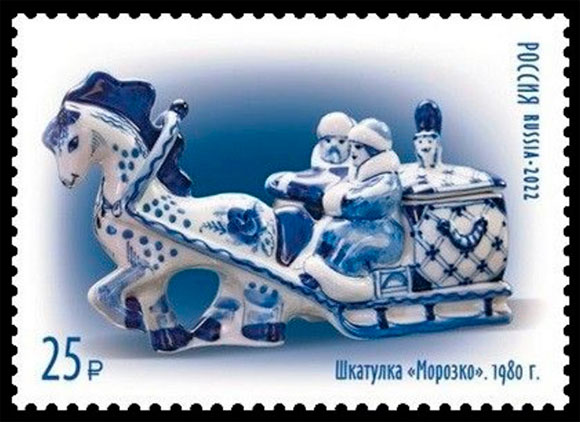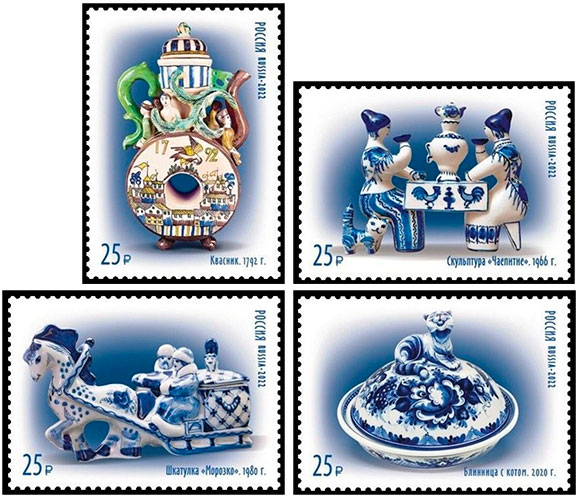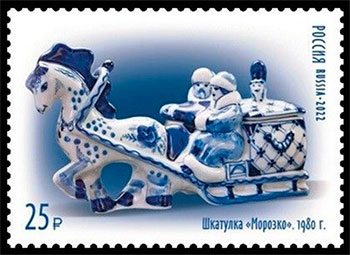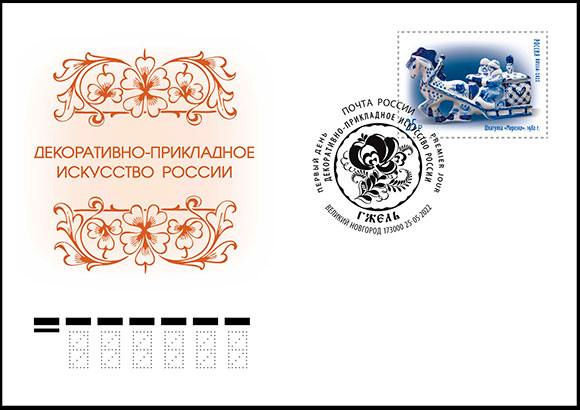
On May 25, 2022, the Russian Post released the series "Decorative and Applied Art of Russia. Gzhel"
Gzhel is a traditional Russian craft, a special kind of painting on ceramics. The series was developed with the participation of the employees of the Gzhel Porcelain Factory Museum, it reflects the history of the development of this artistic craft from the end of the 18th century to the present day. The first stamp depicts a multi-colored fermenter of 1792, the next two: the sculpture "Tea Party" (1966) and the box "Morozko" (1980) are products of Soviet Gzhel classic masters. The last stamp of the series features a crepe maker with a cat on the lid (2020) - the work of a modern author from the Gzhel factory.

The village of Gzhel and the surrounding settlements, the so-called "Gzhel bush", have long been famous for their clays. Extensive mining of various types of clay has been carried out here since the middle of the 17th century. Back in 1663, during the reign of Tsar Alexei Mikhailovich, clay was brought from there for the manufacture of pharmaceutical and alchemical vessels. In the 1740s chemist Dmitry Vinogradov created the first Russian porcelain products from local clay. Around 1800, the composition of a white faience mass was found in the village of Volodino. In the same place, around 1804, the first porcelain factory was founded. By 1812, there were already 25 factories in Gzhel producing dishes, as well as toys and decorative figurines on themes from Russian life.
The now traditional blue and white painting appeared on Gzhel porcelain also at the beginning of the 19th century. Its appearance is due to the fact that the blue paint obtained from cobalt oxide was the only dye that did not lose its color when items were fired at high temperatures. On unfired objects, blue cobalt appears black and acquires its signature blueness only after the second firing.
Another characteristic feature of Gzhel painting is a slightly vague pattern and the absence of clear contours. This is due to a special underglaze method of painting, when a drawing is first applied, then the product is covered with glaze and fired. When re-glazing over the painting and firing, the pattern is slightly blurred. A variety of dishes, as well as toys and figurines, were painted with blue paint on a white background in a peculiar folk style, with motifs of decorative flowers, leaves and herbs.
The heyday of the Gzhel crafts falls on the second quarter of the 19th century. After the revolution, industrial production in Gzhel stopped, porcelain and faience were produced by handicraftsmen. In 1945–1949 the third stage of the development of the Gzhel industry began. The use of cobalt paints on white clay was approved. A special atlas of strokes was created to unify the style of production. Today, several enterprises operate in Gzhel at once, where they produce not only dishes and figurines, but also ceramic tiles, clocks, chandeliers and telephone sets.

A striking example of Gzhel decorative porcelain of the Soviet period is the Morozko box. The box was created in 1980, based on a Russian folk tale. Morozko and Nastenka are sitting in a sleigh pulled by a frisky horse, and behind them is a large dowry chest that can be used to store jewelry or various small things. Looking at this box, you immediately get a joyful feeling of a winter fairy tale, where goodness has won and everyone is smiling happily, even a snow-white horse in blue Gzhel apples. The box is stored in the museum of Gzhel Art Workshops LLC.
The stamps were issued in sheets (3 x 5) with decorative margins of 15 stamps each. In addition to stamps, the Post has prepared first-day stamps (for Moscow, Veliky Novgorod and Rechitsy, Moscow Region) and maximum cards.
The presentation of the stamps took place on May 25 at the Gzhel Porcelain Factory, and the ceremony of commemorative cancellation of stamps was held in the village of Rechitsy, Moscow Region.

Перейти в каталог
I apologize for any errors or inaccuracies


